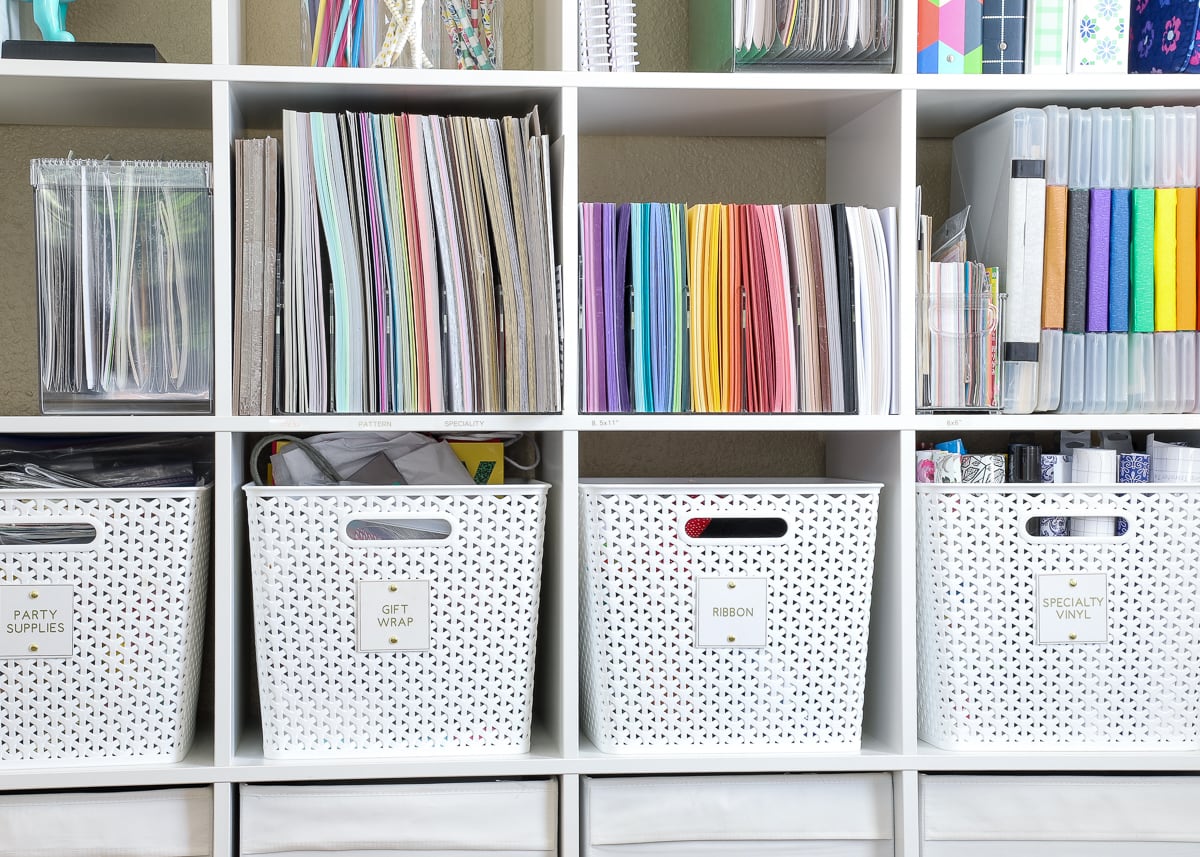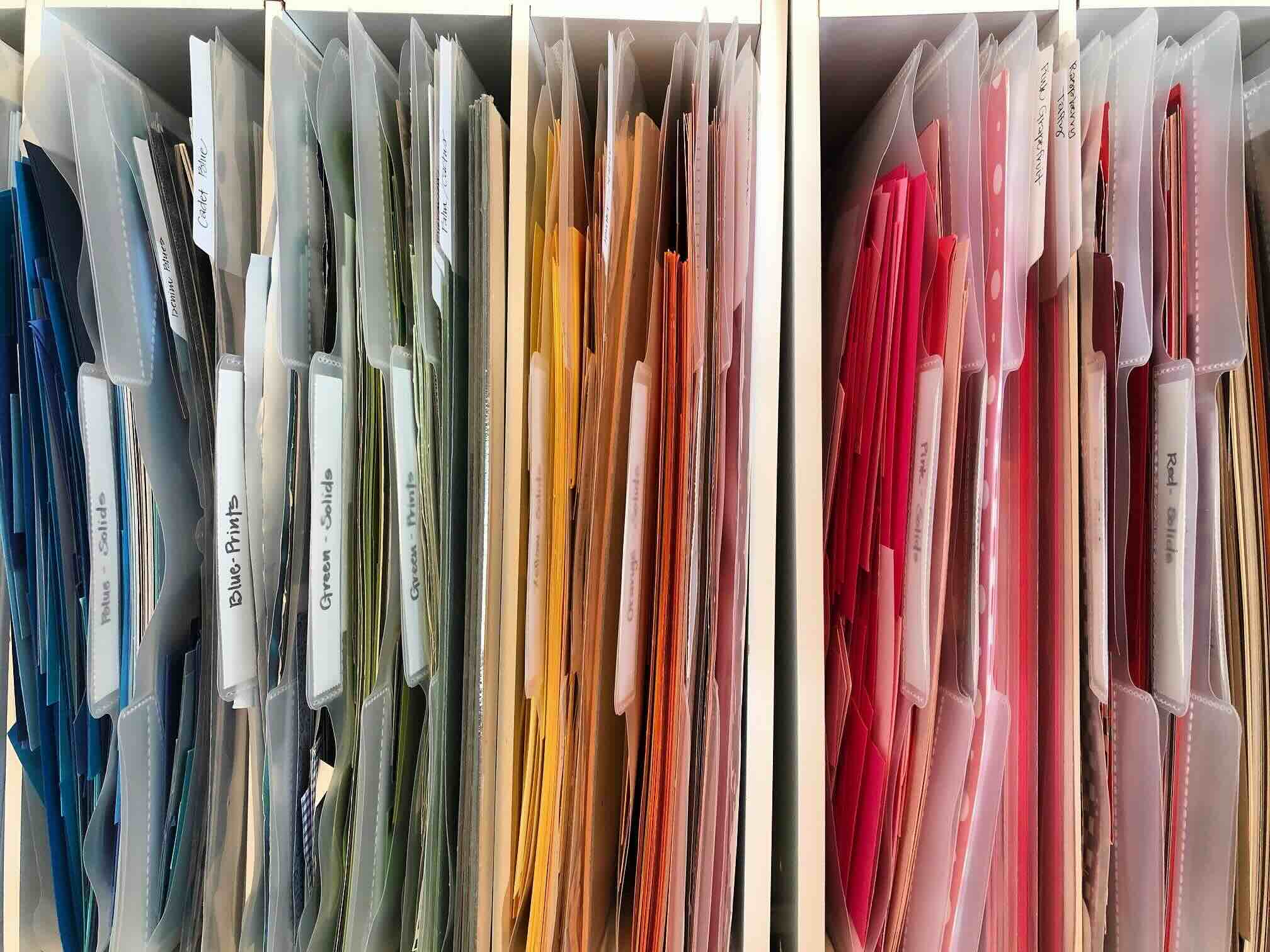

Articles
How To Store Construction Paper
Modified: August 16, 2024
Learn how to properly store construction paper with our helpful articles. Find step-by-step guides and tips to keep your construction paper organized and in good condition.
(Many of the links in this article redirect to a specific reviewed product. Your purchase of these products through affiliate links helps to generate commission for Storables.com, at no extra cost. Learn more)
Introduction
Construction paper is a versatile and widely used material in various art and craft projects. Its vibrant colors and sturdy texture make it a favorite among children and adults alike. However, keeping construction paper organized and properly stored can be a challenge, especially if you have a large collection. Without proper storage, construction paper can become wrinkled, faded, or damaged, making it less usable for future projects.
In this article, we will guide you through the process of storing construction paper to ensure its longevity and usability. By following a few simple steps and utilizing appropriate storage methods, you can keep your construction paper neat, organized, and in excellent condition.
Key Takeaways:
- Organize construction paper by color, size, and category to create a visually appealing and easily accessible storage system. Regularly declutter and update to maintain organization and usability.
- Choose suitable storage methods such as file folders, plastic bins, or hanging file folders to protect construction paper from damage and ensure easy access. Label and categorize for efficient retrieval and maintenance.
Read more: How To Store Paper Documents
Step 1: Gather Your Supplies
Before you start organizing and storing your construction paper, it is important to gather all the necessary supplies. This will ensure that you have everything you need at hand and make the process smoother. Here are the supplies you will need:
- Construction paper
- Scissors or paper trimmer
- Pens or markers
- File folders or plastic bins
- Labels or adhesive tags
Having these supplies readily available will make the sorting and organizing process much more efficient.
Step 2: Sort and Organize
Once you have gathered your supplies, it’s time to sort and organize your construction paper. Start by gathering all of your construction paper and placing it in one central location. This will allow you to see the full extent of your collection and make the sorting process easier.
Next, begin sorting your construction paper based on different criteria. One option is to sort by color, grouping all the red paper together, all the blue paper together, and so on. Another option is to sort by size, separating the larger sheets from the smaller ones. You can also sort based on patterns or themes if you have a specific purpose in mind.
As you sort, consider decluttering your collection. Discard any scraps of construction paper that are too small to use or have become damaged beyond repair. This will help you streamline your collection and make the storage process more manageable.
During the sorting process, you can also take the opportunity to organize your construction paper into categories. This can be done by using different labeled sections or containers for each category. For example, you could have separate sections for solid colors, patterns, and specialty papers.
By sorting and organizing your construction paper, you will not only make it easier to find specific sheets when you need them, but you will also create a more visually appealing storage system.
Step 3: Choose a Storage Method
Now that you have sorted and organized your construction paper, it’s time to choose a storage method that best suits your needs and space constraints. There are several options to consider:
Option 1: File Folders
Using file folders is a simple and effective way to store construction paper. Purchase a set of file folders, preferably in different colors to correspond with the paper categories you created during the sorting process. Label each folder with the appropriate category name and place the corresponding construction paper inside. You can stack the folders vertically in a file cabinet or a sturdy box.
Read more: How To Store Wrapping Paper
Option 2: Plastic Bins
If you have a larger collection of construction paper, plastic bins provide ample storage space and protection. Choose clear plastic bins with lids, as they allow you to easily see the contents inside. Group the construction paper by category and place them inside the bins, making sure to label the bins accordingly.
Option 3: Hanging File Folders
If you prefer to hang your construction paper, hanging file folders are an excellent option. Purchase hanging file folders and label each one with a specific category. Place the construction paper inside the corresponding folders and hang them in a file cabinet or a dedicated storage rack.
When choosing a storage method, consider the amount of construction paper you have, the available storage space, and your personal preference. The goal is to keep the paper well-organized, easily accessible, and protected from any potential damage.
Option 1: File Folders
Using file folders is a simple and efficient way to store and organize your construction paper. Here’s how you can utilize file folders to keep your paper in excellent condition:
1. Purchase a set of file folders that are sturdy and properly sized to accommodate your construction paper.
2. Consider using different colored file folders that correspond to the categories you created during the sorting process. For example, you can assign red folders for solid colors, blue folders for patterns, and so on.
3. Label each file folder with the appropriate category name using a pen or marker. This will help you easily identify and locate specific types of paper.
4. Place the corresponding construction paper inside the labeled file folders. Be mindful of the size and thickness of each sheet to ensure they fit comfortably without becoming bent or creased.
5. You can stack the file folders vertically inside a file cabinet, storage box, or a dedicated storage container.
6. Arrange the folders in a way that makes it easy to access the specific type of construction paper you need. You can alphabetize them, group them by color or pattern, or use any other organizational method that works for you.
7. Consider using dividers or index tabs within the file folders to further categorize and separate different types of paper within each folder. This can be especially helpful if you have a large quantity of paper in a single category.
8. Regularly check and rearrange the file folders as needed to maintain order and ensure all the paper is in its appropriate place.
Using file folders not only provides a neat and organized storage solution but also protects your construction paper from dust, bending, and other potential damage. It also allows for easy browsing and quick access to different types of paper when starting a new project.
Remember to periodically go through your file folders to remove any unused or damaged construction paper, keeping your collection up-to-date and clutter-free.
Option 2: Plastic Bins
If you have a larger collection of construction paper or prefer a more spacious storage option, using plastic bins can be an excellent choice. Follow these steps to effectively store and organize your construction paper using plastic bins:
1. Choose clear plastic bins with lids that are large enough to accommodate your construction paper collection. Clear bins allow you to easily see the contents inside without having to open each one.
2. Group your construction paper by category, such as solid colors, patterns, or specialty papers. This will help you locate specific types of paper more easily.
3. Label each bin with the corresponding category using adhesive tags or labels. This will make it simple to identify the content of each bin at a glance.
4. Place the construction paper neatly inside the bins, ensuring that the sheets are flat and not folded or crumpled. Be careful not to overstuff the bins as it may lead to damage or difficulty in accessing the paper.
5. If your construction paper collection spans multiple bins, consider stacking them vertically to save space. Make sure to label the bins accordingly to make retrieval easier.
6. Store the bins in a dry and protected area, away from direct sunlight or moisture that could potentially damage the paper.
7. Periodically check the bins to ensure the paper is still in good condition and make any necessary adjustments or replacements.
Using plastic bins for construction paper storage offers several benefits. The clear bins allow for easy visibility, making it simple to locate and retrieve the desired paper. The bins also provide protection against dust, moisture, and bending, ensuring that your construction paper remains in excellent condition for future projects. Additionally, the bins can be easily stacked or stored on shelves, maximizing your storage space.
Remember to periodically go through your collection to remove any unused or damaged construction paper, keeping your bins organized and maintaining the quality of your papers. With proper organization and storage, your construction paper will be readily accessible and well-preserved for your creative endeavors.
Read more: How To Store Paper Artwork
Option 3: Hanging File Folders
If you prefer to hang your construction paper for easy access and visibility, hanging file folders are an excellent storage option. Follow these steps to effectively store and organize your construction paper using hanging file folders:
1. Purchase hanging file folders specifically designed to hold construction paper. These folders are typically wider and sturdier than standard file folders to accommodate the larger dimensions of construction paper.
2. Label each hanging file folder with a specific category or color using adhesive labels or tags. This will help you easily identify and locate different types of paper.
3. Place your construction paper inside the corresponding hanging file folders. Ensure that the paper is flat and aligned neatly within the folder to avoid creasing or bending.
4. Hang the file folders in a file cabinet, a dedicated storage rack, or a closet rail. Make sure the hanging files are secure and evenly spaced to prevent sagging or bending of the folders.
5. Arrange the hanging file folders in a logical order that works for you, such as by color, pattern, or size. This will help you quickly locate the specific type of construction paper you need.
6. Consider using additional dividers or tabs within each hanging file folder to further categorize or organize different types of paper.
7. Regularly check and rearrange the hanging file folders as needed to maintain order and ensure that all the paper is properly stored and accessible.
Using hanging file folders for construction paper storage offers several advantages. The vertical arrangement allows for easy browsing and quick access to different types of paper. It also minimizes the risk of damage from folding or crumpling that can occur with other storage methods. Additionally, the hanging file folders provide a compact storage solution, making efficient use of space.
Remember to periodically go through your hanging file folders to remove any unused or damaged construction paper. This will help keep your collection organized and ensure that only the highest quality paper is readily available for your creative projects. With the use of hanging file folders, your construction paper will be neatly stored and easily accessible for all your artistic endeavors.
Store construction paper in a cool, dry place to prevent warping or discoloration. Use plastic bins or file folders to keep the paper organized and easily accessible.
Step 4: Label and Categorize
After sorting and choosing a storage method for your construction paper, the next step is to label and categorize your stored paper. Proper labeling and categorization will help you easily identify and locate specific types of paper whenever you need them. Here’s how you can accomplish this:
- Review your sorted construction paper and determine the different categories you want to create. This can be based on color, pattern, size, or any other criteria that make sense for your collection.
- Prepare labels or adhesive tags that correspond to each category. You can use pre-made labels or create your own using markers or label-making tools. Ensure that the labels are clear and easy to read.
- Apply the labels to your chosen storage method, whether it’s file folders, plastic bins, or hanging file folders. Place the labels on the front or top of each storage unit, ensuring they are easily visible.
- Organize your construction paper into the designated categories. Place each sheet of paper in the appropriate storage unit or section based on its color, pattern, or size.
- Consider using subcategories or additional labeling within each category to further organize your paper. For example, within the “Solid Colors” category, you can have subcategories for primary colors, secondary colors, and so on.
- Regularly review and update your labels and categories as needed. If you acquire new construction paper or find that your existing categories are not practical, make adjustments to ensure an efficient and organized system.
Proper labeling and categorization will save you time and effort when searching for specific types of construction paper. It will also help maintain the organization of your storage system and prevent papers from getting mixed up or misplaced.
Remember to keep a record of your categories and labels, either electronically or in a physical notebook, to easily reference them when adding new papers or retrieving specific sheets. With a well-labeled and categorized collection, you’ll have a streamlined and efficient system for accessing your construction paper whenever inspiration strikes.
Step 5: Store in a Suitable Location
Now that you have sorted, chosen a storage method, labeled, and categorized your construction paper, it’s time to find a suitable location to store your collection. The right storage location will ensure your construction paper remains in good condition and readily accessible. Follow these guidelines for storing your construction paper:
- Choose a dry and cool area to store your construction paper. High humidity or extreme temperature variations can negatively impact the quality and longevity of the paper.
- Avoid storing your construction paper in direct sunlight as exposure to UV rays can fade the colors over time.
- Make sure the storage area is clean, free from dust, and well-ventilated to prevent the accumulation of dust or mold on the paper.
- If possible, store your construction paper in a dedicated storage space to prevent it from being crushed or damaged by other items.
- If you opted for file folders or hanging file folders, a file cabinet, storage box, or a dedicated storage rack can be appropriate. Just make sure that the storage unit is sturdy enough to hold the weight of the paper and is easily accessible.
- If using plastic bins, stack them on sturdy shelves or in a closet to keep them off the ground. This helps prevent any potential damage from moisture or pests.
- Ensure that your storage space is easily accessible, allowing you to retrieve and return construction paper without hassle. This will encourage you to maintain the organization and neatness of your collection.
- Keep the stored construction paper away from potential hazards such as water sources, sharp objects, or chemicals that could damage or stain the paper.
By storing your construction paper in a suitable location, you can protect it from damage, keep it organized, and ensure it remains in good condition for future use. Regularly check the storage area for any signs of humidity, pests, or other environmental issues, and address them promptly to maintain the integrity of your paper collection.
Remember to keep the storage space well-maintained and periodically review your collection for any adjustments needed. With proper storage, your construction paper will be readily available whenever creativity strikes.
Conclusion
Properly storing construction paper is essential for preserving its quality and ensuring its usability for future projects. By following the steps outlined in this article, you can effectively organize and store your construction paper collection:
Start by gathering your supplies, including construction paper, scissors or a paper trimmer, pens or markers, file folders or plastic bins, and labels or adhesive tags. Sorting and organizing your construction paper into categories will make it easier to find specific sheets when needed. Choose a storage method that suits your needs, whether it’s file folders, plastic bins, or hanging file folders.
Labeling and categorizing your construction paper will help you easily identify and locate specific types of paper. Store your construction paper in a suitable location, ensuring it is kept dry, cool, and away from direct sunlight. Regularly check your collection and make any necessary adjustments or replacements to maintain its organization and quality.
By implementing these storage techniques, you can keep your construction paper neatly organized, protected from damage, and easily accessible for all your creative projects. Whether you’re a teacher, parent, or artist, a well-maintained collection of construction paper will inspire and enable you to bring your artistic ideas to life.
Remember that the joy of using construction paper goes beyond its vibrant colors and versatility. It’s about fostering creativity, exploring artistic possibilities, and embracing the satisfaction of expressing oneself through craft. With a well-organized and properly stored construction paper collection, you’re ready to embark on countless artistic adventures!
Frequently Asked Questions about How To Store Construction Paper
Was this page helpful?
At Storables.com, we guarantee accurate and reliable information. Our content, validated by Expert Board Contributors, is crafted following stringent Editorial Policies. We're committed to providing you with well-researched, expert-backed insights for all your informational needs.














0 thoughts on “How To Store Construction Paper”